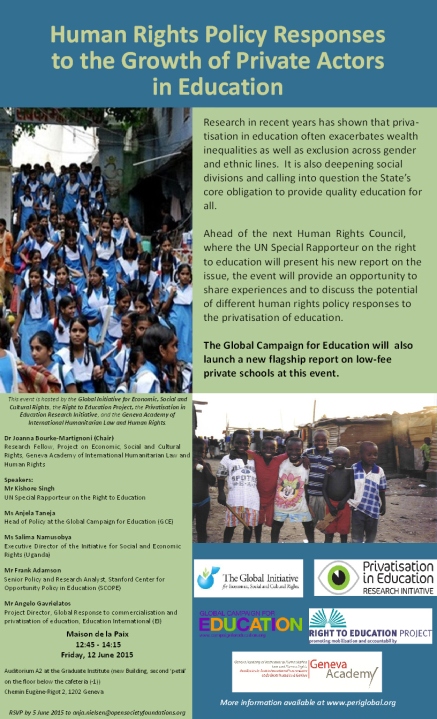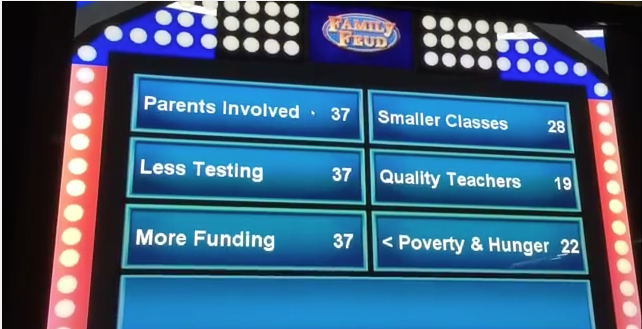The world is experiencing the spread of privatizing GERMs (Global Education Reform Movements).
School “reformers” are pressing a variety of “school choice” and “market-based” policies that move the control of schools from democratic control to private control. Market-based approaches such as vouchers, charters, and parent trigger take the control of schools out of the hands of democratically elected governmental officials and local communities.
Not only are “choice” and “market-based” policies spreading across the United States, but the world is also facing privatization efforts. The United Nations recently convened a meeting to address the GERMs. I will begin with a quick discussion of primary domestic privatization efforts and then segue to the global pushback.
The two most prominent forms of private control pressed in educational policy in the United States are charters and vouchers. Choice proponents focus on the limitations of traditional public schools but rarely discuss the predominance of the peer-reviewed research literature that demonstrates limited or no effect of choice (i.e. vouchers and charters) on student success. Are there examples of student success in charters? Of course, as is there also in public schools. However, the most prominent CREDO study of charter schools across the nation showed that nationwide only 15% of charters perform better than traditional neighborhood public schools.
While it is true that you can find an occasional peer-reviewed study that shows small effects for vouchers, the predominance of the research literature in the United States and elsewhere in the world shows no statistical significance or limited effects. What is also notable about the rare voucher study that shows a positive effect is that they are typically churned out by researchers primarily funded by foundations that are ideologically privatization advocates (aka Kool-Aid drinkers). What charters and vouchers clearly do is hand the control of the capital in schools to religious organizations, politically appointed boards and/or corporations.
Parent Trigger is a policy where parents are allowed to vote to turn over a public school to private control. Parent Trigger is parent empowerment without the empowerment. Parental involvement without the involvement. Why? Students and parents rights are actually more limited. Once a trigger petition is voted on and goes forward, the rights that are often guaranteed to parents, students and teachers under the democratically defined education code are usually squelched. Under private control, parents and students no longer have guarantees on class size limits, disciplinary decisions, or qualified teachers among others.
Also, as real estate agents often say “Location!, Location!, Location!” Schools often sitting on very valuable parcels of land. It would be a coup for those shopping for real estate and facilities if just a few parents from any particular year are given the reins to easily transfer hundreds of millions of dollars in public assets. Furthermore, parent trigger legislation is typically flawed, as parents should have the option to cancel the contract and return to public management if they so choose. Parent Trigger shouldn’t be a one-way street. Families should also be able to make the choice to leave private control and return to public control if they are underwhelmed by the undemocratic, non-local, control of their school.
Another hot topic is the rise of virtual (online) charter schools. What high schooler wouldn’t want to sit at home and pretend to go to school and have the school pretend that they attend? The results of virtual schools has been dismal. For example, In the Public Interest’s reported entitled Virtual Public Education in California: A Study of Student Performance, Management Practices and Oversight Mechanisms at California Virtual Academies, a K12 Inc. Managed School System found,
The virtual education model advanced by K12 Inc. in California does not adequately serve many of its students. In every year since it began graduating students, except 2013, CAVA has had more dropouts than graduates. Its academic growth was negative for most of its history and it did not keep up with other demographically similar schools after 2005. Its Academic Performance Index scores consistently ranked poorly against other demographically similar schools and the state as a whole. Evidence of low quality educational materials, under- staffing of clerical employees and low teacher salaries all indicates that an additional investment of resources in the classroom is necessary for improvement.
The financial profiteering and lack of success of students enrolled in virtual charters by the National Education Policy Center was summed up by Kevin Welner, University of Colorado Boulder Professor, who stated that they “raises enormous red flags.”
Private control is problematic. What occurs is a few individuals— often elites— gain control of districts and schools rather than democratically controlled education policy. Disingenuously, there is a simultaneous promotion of an elegant, but false, narratives of Civil Rights and economic efficiencies as benefits of their top down approaches. However, what the anti-democratic policies really offer is the opportunity for the elites to profit handsomely from the education system by privately controlling the capital.
The United Nations recently took notice of the move to privatize education in the United States and elsewhere. Education International reported,
In what is being hailed as a landmark resolution, the United Nations Human Rights Council has urged States to regulate and monitor private education providers as well as recognise the threat of commercialised education.
The HRC is the leading global inter-governmental political body dealing with human rights. In the resolution adopted by consensus of its 47 members, the HRC has, for the first time, responded to the growing phenomenon of privatisation and commercialisation of education.
This phenomenon, and in particular the emergence of large-scale for-profit “low-cost” private school chains targeting poor families in developing countries, has received heightened attention from civil society organisations and UN expert bodies alike in recent months.
Camilla Croso, of the Global Campaign for Education, reacted: “the rapid, unregulated growth of private providers of education is already creating – and enabling – violations of the right to education, threatening to erase the last 50 years of progress in access to education. This resolution shows that States have realised that they must act now to regulate such providers – before it is too late.”
Sylvain Aubry, of the Global Initiative for Economic, Social and Cultural Rights elaborated: “Our research has consistently shownthat privatisation in education leads to socio-economic segregation and discrimination against the poorest children in schools, in violation of States’ obligations, as was recently recognisedin the case of Chile. The resolution adopted today, crucially highlights the obligation to provide educational opportunities for all without discrimination.”
I was listening to NPR the other day and they had a story about the low cost, standardized curriculum for-profit private schools that are proliferating in India and elsewhere. My first thought was that it was a good idea. But, as I thought more carefully, I realized that the point of these schools is to destabilize the public systems and profit simultaneously.
 The Global Campaign for Education held a meeting in Geneva to bring together organizations and scholars to discuss privatization and commercialization. Frank Adamson attended the recent meeting. I first met Frank when we were working on our doctorates at Stanford (he plays a mean striker in intramural soccer). He is a senior policy and research analyst at SCOPE and co-editor of the forthcoming book “Global Education Reform: How Privatization and Public Investment Influence Education Outcomes” due out in January. He travelled to the recent meeting in Geneva.
The Global Campaign for Education held a meeting in Geneva to bring together organizations and scholars to discuss privatization and commercialization. Frank Adamson attended the recent meeting. I first met Frank when we were working on our doctorates at Stanford (he plays a mean striker in intramural soccer). He is a senior policy and research analyst at SCOPE and co-editor of the forthcoming book “Global Education Reform: How Privatization and Public Investment Influence Education Outcomes” due out in January. He travelled to the recent meeting in Geneva.
Frank writes:
The meetings in Geneva revealed that the privatization and commercialization of public education is indeed a global phenomenon. The panel discussions ranged from low-fee private schools in Uganda and Ghana to public-private partnerships in Nepal and Philippines, vouchers in Chile, markets in Sweden, and corporate charters in the U.S. The pace and mechanisms of these approaches differ in each country context. However, the theme of profits displacing learning is consistent across contexts.
The profit in question comes from taxpayer money intended for public education. A variety of actors – from venture capitalists to the World Bank, technology firms, and local companies – have labeled public education as a “$4.625 trillion dollar space” and set their sights on taking home a slice of that pie. The Geneva meetings provided a more coordinated critique of this attempted takeover of education, a sector that most people support as publicly funded for the public interest, not private profit.”
The focus on profit and its corollaries – standardization, high-stakes testing, and cheaper labor (inexperienced teachers) – isn’t producing better education globally. Geneva revealed the failures and fallacies of the privatized approaches in different countries, illustrating that it’s now time to ensure that the public investment in education is channeled into the public interest. The roadmap is also clear, as the highest performing and most equitable countries in the world (Finland, Singapore, Canada, and Cuba, to name a few) use public investment strategies that produce the education outcomes that parents expect and would like to see for children worldwide.
 GERMs are bad for the health of public education. Vaccinate yourself with the necessary knowledge to combat their spread. In conclusion, I’ll discuss privatization tomorrow here at Netroots. If you are here at Netroots or in Phoenix community come by and say hi.
GERMs are bad for the health of public education. Vaccinate yourself with the necessary knowledge to combat their spread. In conclusion, I’ll discuss privatization tomorrow here at Netroots. If you are here at Netroots or in Phoenix community come by and say hi.
Want to know about Cloaking Inequity’s freshly pressed conversations about educational policy? Click the “Follow blog by email” button in the upper left hand corner of this page.
Please blame Milton Friedman for any typos.
Twitter: @ProfessorJVH
Click here for Vitae.
The video below includes a panel discussion that includes Dr. Adamson and a UN Special Rapporteur. The panel provided a variety of international perspectives on education privatization.







You must be logged in to post a comment.